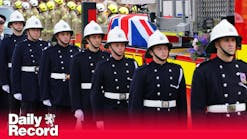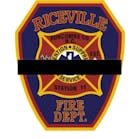It appears that the “bad guys” (criminal elements and terrorists) are more determined, violent and heavily armed than ever before. Crisis situations such as terrorist threats, criminal attacks and active shooters are occurring with alarming frequency.
DISPATCH AND RESPONSE PHASE
• Nature of the call and location are important. When responding get all the dispatch information available.
• Current threat environment and intelligence could be applicable to a mass shooting/active shooter response. Is location a school, college or high profile business?
ARRIVAL ON SCENE
• Slow down when approaching the area and conduct a 360-degree scan during your scene size-up or “windshield survey”.
• Look for people, activities and objects that seem out of place for the location or time of the call - if it looks suspicious it probably is.
• Use secured Staging Area to limit number of responders - don't stack up responders and resources in one location. This also makes resource coordination more manageable.
• Quickly establish an outer security perimeter.
• ALWAYS BE AWARE OF SECONDARY ATTACKS OR THREATS!
APPROACHING THE AREA
• Utilize Incident Command System (ICS) and Unified Command ASAP!
• Establish Hazard Control Zones around the suspected or actual event (Hot, Warm, and Cold). Limit the number of responders entering the “Hot Zone”.
• Always have an escape route open to leave the scene quickly if needed.
• Scan the area using binoculars: spotting scopes or vehicle-mounted cameras if possible before approaching.
• If you must approach the event use shielding and cover to your advantage.
• Law Enforcement will deploy quickly using Rapid Deployment/Immediate Deployment Tactics.
RESPONSE
• Responder’s safety is paramount during this type of event!
• Fire and EMS should remain in staging area until the scene is secured by law enforcement when possible.
• Situations could become a hostage situation.
• Armed perpetrator(s) may have fled the scene, may be injured/fatality or remain active on the scene.
• Immediate interagency cooperation/Unified Command is essential.
• Body armor should be obtained for those responding into the "impact" area when possible.
• Law Enforcement, Fire and EMS personnel should wear clearly marked jackets/identification.
• EMS may need to implement disaster procedures such as tactical medics, triage tags, casualty collection points and field treatment areas for minor injuries.
• Staging, command, triage, and treatment areas MAY have to be ½ to 1 mile away from the scene due to the distance a round can travel.
FIRE/EMS
• Only enter the scene if it is confirmed that all suspects are confined or neutralized!
• Only a small number of fire and/or EMS personnel should enter under these circumstances.
• May adopt a “scoop and run” and “load and go” response during an active threat.
• Additional law enforcement officers should ensure safe passage/force protection.
PRE-INCIDENT PLANNING
• Multi-agency pre-planning is critical!
• Notify all key agencies supporting entities as soon as possible (Emergency Management, Hospitals, etc.)
• Be prepared for schools, businesses and other locations to be in a “lockdown mode”.
• Plan on large and immediate media response and parents, family and friends response to the incident scene.
AUGUST VERNON works in emergency management and provides specialized emergency services planning and training for critical incidents. The “First Responders Critical Incident Guide” is available from Red Hat publishing at www.redhatpub.com

August Vernon
AUGUST VERNON is the operations officer for the Forsyth County Office of Emergency Management in Winston-Salem, NC. He served in the U.S. Army as a chemical, biological, radiological and nuclear (CBRN) operations specialist. He is a writer and member of the International Fire Service Training Association (IFSTA) WMD/Terrorism Committee. Vernon is the author of the new First Responders Critical Incident Guide published by Red Hat Publishing.





